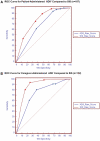The Six-Item Screener and AD8 for the detection of cognitive impairment in geriatric emergency department patients
- PMID: 20855129
- PMCID: PMC3213856
- DOI: 10.1016/j.annemergmed.2010.06.560
The Six-Item Screener and AD8 for the detection of cognitive impairment in geriatric emergency department patients
Abstract
Study objective: We evaluate the diagnostic test characteristics of the Six-Item Screener and the AD8 to detect cognitive dysfunction in adults older than 65 years and using the emergency department (ED) for any reason.
Methods: We conducted an observational cross-sectional cohort study at a single academic urban university-affiliated hospital. Subjects were consenting, non--critically ill, English-speaking adults older than 65 years and receiving care in the ED. We quantitatively assessed the diagnostic test characteristics of the Six-Item Screener and AD8 by using the Mini-Mental State Examination score less than 24 as the criterion standard for cognitive dysfunction.
Results: The prevalence of cognitive dysfunction was 35%, but only 6% of charts noted a pre-existing deficit. The Six-Item Screener was superior to either the caregiver-administered AD8 or the patient-administered AD8 for the detection of cognitive dysfunction.
Conclusion: The Six-Item Screener was superior to the caregiver- or patient-administered AD8 to identify older adults at increased risk for occult cognitive dysfunction.
Copyright © 2010 American College of Emergency Physicians. Published by Mosby, Inc. All rights reserved.
Figures




References
-
- Roberts DC, McKay MP, Shaffer A. Increasing rates of emergency department visits for elderly patients in the United States, 1993 to 2003. Ann Emerg Med. 2008;51:769–774. - PubMed
-
- Fitzgerald RT. American College of Emergency Physicians White Paper. The Future of Geriatric Care in Our Nation’s Emergency Departments: Impact and Implications. 2008 Available at http://www.acep.org/Work-Area/DownloadAsset.aspx?id=43376.
-
- Hwang U, Morrison RS. The geriatric emergency department. J Am Geratr Soc. 2007;55:1873–1876. - PubMed
-
- Lewis LM, Miller DK, Morley JE, et al. Unrecognized delirium in ED geriatric patients. Am J Emerg Med. 1995;13:142–145. - PubMed
Publication types
MeSH terms
Grants and funding
LinkOut - more resources
Full Text Sources

